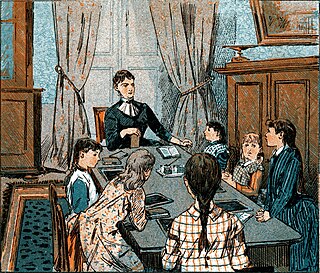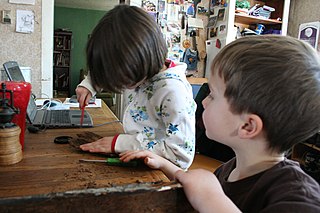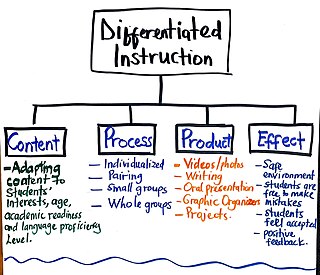Related Research Articles

Education is a purposeful activity directed at achieving certain aims, such as transmitting knowledge or fostering skills and character traits. These aims may include the development of understanding, rationality, kindness, and honesty. Various researchers emphasize the role of critical thinking in order to distinguish education from indoctrination. Some theorists require that education results in an improvement of the student while others prefer a value-neutral definition of the term. In a slightly different sense, education may also refer, not to the process, but to the product of this process: the mental states and dispositions possessed by educated people. Education originated as the transmission of cultural heritage from one generation to the next. Today, educational goals increasingly encompass new ideas such as the liberation of learners, skills needed for modern society, empathy, and complex vocational skills.
The following outline is provided as an overview of and topical guide to education:
Progressive education, or protractivism, is a pedagogical movement that began in the late 19th century and has persisted in various forms to the present. In Europe, progressive education took the form of the New Education Movement. The term progressive was engaged to distinguish this education from the traditional curricula of the 19th century, which was rooted in classical preparation for the university and strongly differentiated by social class. By contrast, progressive education finds its roots in modern experience. Most progressive education programs have these qualities in common:

Homeschooling or home schooling, also known as home education or elective home education (EHE), is the education of school-aged children at home or a variety of places other than a school. Usually conducted by a parent, tutor, or an online teacher, many homeschool families use less formal, more personalized and individualized methods of learning that are not always found in schools. The actual practice of homeschooling can look very different. The spectrum ranges from highly structured forms based on traditional school lessons to more open, free forms such as unschooling, which is a lesson- and curriculum-free implementation of homeschooling. Some families who initially attended a school go through a deschool phase to break away from school habits and prepare for homeschooling. While "homeschooling" is the term commonly used in North America, "home education" is primarily used in Europe and many Commonwealth countries. Homeschooling should not be confused with distance education, which generally refers to the arrangement where the student is educated by and conforms to the requirements of an online school, rather than being educated independently and unrestrictedly by their parents or by themselves.
The philosophy of education is the branch of applied philosophy that investigates the nature of education as well as its aims and problems. It includes the examination of educational theories, the presuppositions present in them, and the arguments for and against them. It is an interdisciplinary field that draws inspiration from various disciplines both within and outside philosophy, like ethics, political philosophy, psychology, and sociology. These connections are also reflected in the significant and wide-ranging influence the philosophy of education has had on other disciplines. Many of its theories focus specifically on education in schools but it also encompasses other forms of education. Its theories are often divided into descriptive and normative theories. Descriptive theories provide a value-neutral account of what education is and how to understand its fundamental concepts, in contrast to normative theories, which investigate how education should be practiced or what is the right form of education.
A teaching method comprises the principles and methods used by teachers to enable student learning. These strategies are determined partly on subject matter to be taught and partly by the nature of the learner. For a particular teaching method to be appropriate and efficient it has to be in relation with the characteristic of the learner and the type of learning it is supposed to bring about. Suggestions are there to design and selection of teaching methods must take into account not only the nature of the subject matter but also how students learn. In today's school the trend is that it encourages much creativity. It is a known fact that human advancement comes through reasoning. This reasoning and original thought enhances creativity.

Unschooling is an informal learning that advocates learner-chosen activities as a primary means for learning. Unschoolers learn through their natural life experiences including play, household responsibilities, personal interests and curiosity, internships and work experience, travel, books, elective classes, family, mentors, and social interaction. Often considered a lesson- and curriculum-free implementation of homeschooling, unschooling encourages exploration of activities initiated by the children themselves, believing that the more personal learning is, the more meaningful, well-understood and therefore useful it is to the child. While courses may occasionally be taken, unschooling questions the usefulness of standard curricula, fixed times at which learning should take place, conventional grading methods in standardized tests, forced contact with children in their own age group, the compulsion to do homework, regardless of whether it helps the learner in their individual situation, the effectiveness of listening to and obeying the orders of one authority figure for several hours each day, and other features of traditional schooling in the education of each unique child.
Humanistic education is an approach to education based on the work of humanistic psychologists, most notably Abraham Maslow and Carl Rogers. Rogers is regarded as the founder of humanistic psychology and devoted much of his efforts toward applying the results of his psychological research to person-centered teaching where empathy, caring about students, and genuineness on the part of the learning facilitator were found to be the key traits of the most effective teachers. He edited a series of books dealing with humanistic education in his "Studies of the Person Series," which included his book, Freedom to Learn and Learning to Feel - Feeling to Learn - Humanistic Education for the Whole Man, by Harold C. Lyon, Jr. In the 1970s the term "humanistic education" became less popular after conservative groups equated it with "Secular Humanism" and attacked the writings of Harold Lyon as being anti-Christian. That began a successful effort by Aspy, Lyon, Rogers, and others to re-label it "person-centered teaching", replacing the term "humanistic education." In a more general sense the term includes the work of other humanistic pedagogues, such as Rudolf Steiner, and Maria Montessori. All of these approaches seek to engage the "whole person": the intellect, feeling life, social capacities, and artistic and practical skills are all important focuses for growth and development. Important objectives include developing children's self-esteem, their ability to set and achieve appropriate goals, and their development toward full autonomy.

The Montessori method of education is a system of education for children that seeks to develop natural interests and activities rather than use formal teaching methods. A Montessori classroom places an emphasis on hands-on learning and developing real-world skills. It emphasizes independence and it views children as naturally eager for knowledge and capable of initiating learning in a sufficiently supportive and well-prepared learning environment. The underlying philosophy can be viewed as stemming from Unfoldment Theory. It discourages some conventional measures of achievement, such as grades and tests.

Student-centered learning, also known as learner-centered education, broadly encompasses methods of teaching that shift the focus of instruction from the teacher to the student. In original usage, student-centered learning aims to develop learner autonomy and independence by putting responsibility for the learning path in the hands of students by imparting to them skills, and the basis on how to learn a specific subject and schemata required to measure up to the specific performance requirement. Student-centered instruction focuses on skills and practices that enable lifelong learning and independent problem-solving. Student-centered learning theory and practice are based on the constructivist learning theory that emphasizes the learner's critical role in constructing meaning from new information and prior experience.
Alternative education encompasses many pedagogical approaches differing from mainstream pedagogy. Such alternative learning environments may be found within state, charter, and independent schools as well as home-based learning environments. Many educational alternatives emphasize small class sizes, close relationships between students and teachers and a sense of community.

Pedagogy, most commonly understood as the approach to teaching, is the theory and practice of learning, and how this process influences, and is influenced by, the social, political and psychological development of learners. Pedagogy, taken as an academic discipline, is the study of how knowledge and skills are imparted in an educational context, and it considers the interactions that take place during learning. Both the theory and practice of pedagogy vary greatly, as they reflect different social, political, and cultural contexts.
A didactic method is a teaching method that follows a consistent scientific approach or educational style to present information to students. The didactic method of instruction is often contrasted with dialectics and the Socratic method; the term can also be used to refer to a specific didactic method, as for instance constructivist didactics.
This is an index of education articles.
Constructivist teaching is based on constructivist learning theory. Constructivist teaching is based on the belief that learning occurs as learners are actively involved in a process of meaning and knowledge construction as opposed to passively receiving information.

Indigenous education specifically focuses on teaching Indigenous knowledge, models, methods, and content within formal or non-formal educational systems. The growing recognition and use of Indigenous education methods can be a response to the erosion and loss of Indigenous knowledge through the processes of colonialism, globalization, and modernity.

Differentiated instruction and assessment, also known as differentiated learning or, in education, simply, differentiation, is a framework or philosophy for effective teaching that involves providing all students within their diverse classroom community of learners a range of different avenues for understanding new information in terms of: acquiring content; processing, constructing, or making sense of ideas; and developing teaching materials and assessment measures so that all students within a classroom can learn effectively, regardless of differences in their ability. Differentiated instruction, according to Carol Ann Tomlinson, is the process of "ensuring that what a student learns, how he or she learns it, and how the student demonstrates what he or she has learned is a match for that student's readiness level, interests, and preferred mode of learning." According to Boelens et al. (2018), differentiation can be on two different levels: the administration level and the classroom level. The administration level takes the socioeconomic status and gender of students into consideration. At the classroom level, differentiation revolves around content, processing, product, and effects. On the content level, teachers adapt what they are teaching to meet the needs of students. This can mean making content more challenging or simplified for students based on their levels. The process of learning can be differentiated as well. Teachers may choose to teach individually at a time, assign problems to small groups, partners or the whole group depending on the needs of the students. By differentiating product, teachers decide how students will present what they have learned. This may take the form of videos, graphic organizers, photo presentations, writing, and oral presentations. All these take place in a safe classroom environment where students feel respected and valued—effects.
Positive education is an approach to education that draws on positive psychology's emphasis of individual strengths and personal motivation to promote learning. Unlike traditional school approaches in which teachers attempt to tailor their material to a mythical "average" student, and move the class altogether using the material through one teaching and testing style, positive schooling teachers use techniques that focus on the well-being of individual students. Teachers use methods such as developing tailored goals for each student to engender learning and working with them to develop the plans and motivation to reach their goals. Rather than pushing students to achieve at a set grade level, seen through the emphasis of standardized testing, this approach attempts to customize learning goals to individual students' levels. Instead of setting students to compete against one another, learning is viewed as a cooperative process where teachers learn to respect their students and each student's input is valued.

The term learning environment can refer to an educational approach, cultural context, or physical setting in which teaching and learning occur. The term is commonly used as a more definitive alternative to "classroom", but it typically refers to the context of educational philosophy or knowledge experienced by the student and may also encompass a variety of learning cultures—its presiding ethos and characteristics, how individuals interact, governing structures, and philosophy. In a societal sense, learning environment may refer to the culture of the population it serves and of their location. Learning environments are highly diverse in use, learning styles, organization, and educational institution. The culture and context of a place or organization includes such factors as a way of thinking, behaving, or working, also known as organizational culture. For a learning environment such as an educational institution, it also includes such factors as operational characteristics of the instructors, instructional group, or institution; the philosophy or knowledge experienced by the student and may also encompass a variety of learning cultures—its presiding ethos and characteristics, how individuals interact, governing structures, and philosophy in learning styles and pedagogies used; and the societal culture of where the learning is occurring. Although physical environments do not determine educational activities, there is evidence of a relationship between school settings and the activities that take place there.

Educational management refers to the administration of the education system in which a group combines human and material resources to supervise, plan, strategise, and implement structures to execute an education system. Education is the equipping of knowledge, skills, values, beliefs, habits, and attitudes with learning experiences. The education system is an ecosystem of professionals in educational institutions, such as government ministries, unions, statutory boards, agencies, and schools. The education system consists of political heads, principals, teaching staff, non-teaching staff, administrative personnel and other educational professionals working together to enrich and enhance. At all levels of the educational ecosystem, management is required; management involves the planning, organising, implementation, review, evaluation, and integration of an institution.
References
- 1 2 3 4 5 6 7 Grant, Barry. "Education Without Compulsion: Toward New Visions of Gifted Education." Journal for the Education of the Gifted. 29.2 (Winter 2005).
- ↑ "Horace Mann (1796-1859)." https://www.pbs.org/kcet/publicschool/innovators/mann.html, 2001. Retrieved: April 27, 2009.
- ↑ Gatto, John Taylor. Dumbing Us Down: The Hidden Curriculum of Compulsory Schooling. Philadelphia: New Society Publishers, 1992.
- ↑ Howley, C., Howley, A., & Pendarvis E. Out of our minds: Anti-intellectualism and talent development in American schooling. New York: Teachers College, 1995.
- ↑ Spring, J. "Sociological and political ruminations." In The twelve-year sentence. W. Rickenbacker, ed. LaSalle, Il: Open Court, 1974.
- ↑ Gatto, John Taylor. "The curriculum of reform." In The exhausted school. J.T. Gatto, ed. New York: Oxford Village Press, 1993.
- ↑ Curti, M. The social ideas of American educators. Paterson, NJ: Pageant, 1959
- ↑ Reitman, S. The educational messiah complex: American faith in the culturally redemptive power of schooling. Sacramento, CA: Caddo Gap, 1992)
- ↑ Green, Don. Teaching in Style. Sundre, AB: Green's Educational Consulting Services, 1998.
- 1 2 Green, Don. Teaching in Style. Sundre, AB: Green's Educational Consulting Services, 1998. Pp 16.
- 1 2 Green, Don. Teaching in Style. Sundre, AB: Green's Educational Consulting Services, 1998. Pp 17.
- ↑ Green, Don. Teaching in Style. Sundre, AB: Green's Educational Consulting Services, 1998. Pp 17-18.
- 1 2 Green, Anne. Let Them Show Us the Way: fostering independent learning in the elementary classroom. Winnipeg, MN: Peguis Publishers Limited, 1995. Pp 9.
- ↑ Green, Anne. Let Them Show Us the Way: fostering independent learning in the elementary classroom. Winnipeg, MN: Peguis Publishers Limited, 1995. Pp 9-11.
- ↑ Green, Anne. Let Them Show Us the Way: fostering independent learning in the elementary classroom. Winnipeg, MN: Peguis Publishers Limited, 1995. Pp 22.
- ↑ Russell L. Ackoff and Daniel Greenberg (2008), Turning Learning Right Side Up: Putting Education Back on Track (pdf - open with Explorer) HTML. Retrieved August 12, 2010.
- ↑ Greenberg, H. (1987), "The Silent Factor," The Sudbury Valley School Experience. Retrieved August 12, 2010.
- ↑ Greenberg, H. (1987), "The Art of Doing Nothing," The Sudbury Valley School Experience. Retrieved August 12, 2010.
- ↑ Mitra, S. (2007) Sugata Mitra shows how kids teach themselves (video – 20:59). Retrieved August 12, 2010.